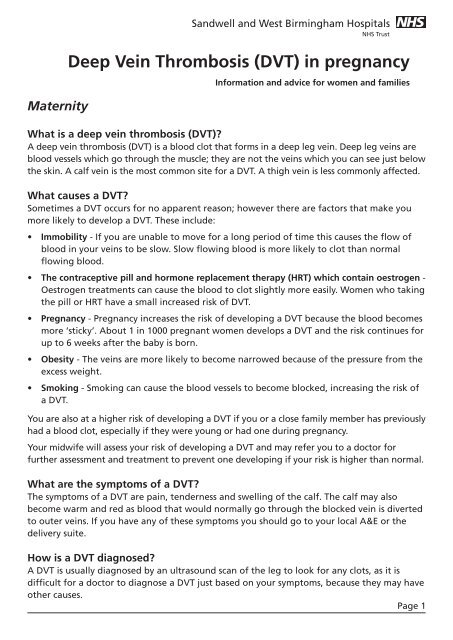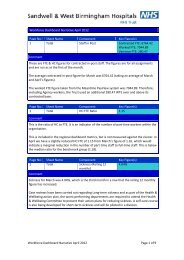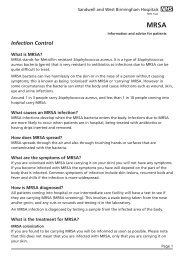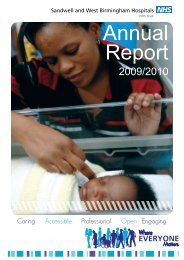Deep Vein Thrombosis (DVT) in pregnancy - Sandwell & West ...
Deep Vein Thrombosis (DVT) in pregnancy - Sandwell & West ...
Deep Vein Thrombosis (DVT) in pregnancy - Sandwell & West ...
Create successful ePaper yourself
Turn your PDF publications into a flip-book with our unique Google optimized e-Paper software.
Maternity<br />
<strong>Deep</strong> <strong>Ve<strong>in</strong></strong> <strong>Thrombosis</strong> (<strong>DVT</strong>) <strong>in</strong> <strong>pregnancy</strong><br />
Information and advice for women and families<br />
What is a deep ve<strong>in</strong> thrombosis (<strong>DVT</strong>)?<br />
A deep ve<strong>in</strong> thrombosis (<strong>DVT</strong>) is a blood clot that forms <strong>in</strong> a deep leg ve<strong>in</strong>. <strong>Deep</strong> leg ve<strong>in</strong>s are<br />
blood vessels which go through the muscle; they are not the ve<strong>in</strong>s which you can see just below<br />
the sk<strong>in</strong>. A calf ve<strong>in</strong> is the most common site for a <strong>DVT</strong>. A thigh ve<strong>in</strong> is less commonly affected.<br />
What causes a <strong>DVT</strong>?<br />
Sometimes a <strong>DVT</strong> occurs for no apparent reason; however there are factors that make you<br />
more likely to develop a <strong>DVT</strong>. These <strong>in</strong>clude:<br />
• Immobility - If you are unable to move for a long period of time this causes the flow of<br />
blood <strong>in</strong> your ve<strong>in</strong>s to be slow. Slow flow<strong>in</strong>g blood is more likely to clot than normal<br />
flow<strong>in</strong>g blood.<br />
• The contraceptive pill and hormone replacement therapy (HRT) which conta<strong>in</strong> oestrogen -<br />
Oestrogen treatments can cause the blood to clot slightly more easily. Women who tak<strong>in</strong>g<br />
the pill or HRT have a small <strong>in</strong>creased risk of <strong>DVT</strong>.<br />
• Pregnancy - Pregnancy <strong>in</strong>creases the risk of develop<strong>in</strong>g a <strong>DVT</strong> because the blood becomes<br />
more ‘sticky’. About 1 <strong>in</strong> 1000 pregnant women develops a <strong>DVT</strong> and the risk cont<strong>in</strong>ues for<br />
up to 6 weeks after the baby is born.<br />
• Obesity - The ve<strong>in</strong>s are more likely to become narrowed because of the pressure from the<br />
excess weight.<br />
• Smok<strong>in</strong>g - Smok<strong>in</strong>g can cause the blood vessels to become blocked, <strong>in</strong>creas<strong>in</strong>g the risk of<br />
a <strong>DVT</strong>.<br />
You are also at a higher risk of develop<strong>in</strong>g a <strong>DVT</strong> if you or a close family member has previously<br />
had a blood clot, especially if they were young or had one dur<strong>in</strong>g <strong>pregnancy</strong>.<br />
Your midwife will assess your risk of develop<strong>in</strong>g a <strong>DVT</strong> and may refer you to a doctor for<br />
further assessment and treatment to prevent one develop<strong>in</strong>g if your risk is higher than normal.<br />
What are the symptoms of a <strong>DVT</strong>?<br />
The symptoms of a <strong>DVT</strong> are pa<strong>in</strong>, tenderness and swell<strong>in</strong>g of the calf. The calf may also<br />
become warm and red as blood that would normally go through the blocked ve<strong>in</strong> is diverted<br />
to outer ve<strong>in</strong>s. If you have any of these symptoms you should go to your local A&E or the<br />
delivery suite.<br />
How is a <strong>DVT</strong> diagnosed?<br />
A <strong>DVT</strong> is usually diagnosed by an ultrasound scan of the leg to look for any clots, as it is<br />
difficult for a doctor to diagnose a <strong>DVT</strong> just based on your symptoms, because they may have<br />
other causes.<br />
Page 1
Maternity<br />
<strong>Deep</strong> <strong>Ve<strong>in</strong></strong> <strong>Thrombosis</strong> (<strong>DVT</strong>) <strong>in</strong> <strong>pregnancy</strong><br />
Information and advice for women and families<br />
What is the treatment for <strong>DVT</strong>?<br />
The treatment for a <strong>DVT</strong> dur<strong>in</strong>g <strong>pregnancy</strong> is <strong>in</strong>jections of Clexane (enoxapar<strong>in</strong>) up to 2 times<br />
a day for 6 months, once a day for the rema<strong>in</strong>der of <strong>pregnancy</strong> and up until 6 weeks after<br />
your baby is born.<br />
Clexane is a blood-th<strong>in</strong>n<strong>in</strong>g drug which is made from animal components and it can also be<br />
used to prevent a <strong>DVT</strong> if your risk of develop<strong>in</strong>g one is high.<br />
What are the benefits of clexane <strong>in</strong>jections?<br />
Clexanes th<strong>in</strong>s the blood which dissolves the <strong>DVT</strong> (or prevents one from develop<strong>in</strong>g), stops it<br />
gett<strong>in</strong>g bigger and prevents it from mov<strong>in</strong>g to other parts of the body. Clexane is considered<br />
to be safe to use <strong>in</strong> <strong>pregnancy</strong> as it doesn’t cross the placenta so does not affect your baby.<br />
What are the risks of clexane <strong>in</strong>jections?<br />
• Bruis<strong>in</strong>g: The most common side effect is bruis<strong>in</strong>g where the <strong>in</strong>jection is given. To prevent<br />
this bruis<strong>in</strong>g do not to rub the area after <strong>in</strong>ject<strong>in</strong>g.<br />
• Bleed<strong>in</strong>g: If you cut yourself you may f<strong>in</strong>d it takes longer for the bleed<strong>in</strong>g to stop; apply a<br />
plaster or a dress<strong>in</strong>g over the wound and press firmly for at least 5 m<strong>in</strong>utes.<br />
The manufacturer’s <strong>in</strong>formation leaflet which comes with the Clexane gives more<br />
<strong>in</strong>formation about any possible side effects. Please read this carefully before us<strong>in</strong>g clexane<br />
for the first time.<br />
What are the risks of not hav<strong>in</strong>g treatment for a <strong>DVT</strong>?<br />
If you do not have treatment for a <strong>DVT</strong> it could lead to one of the follow<strong>in</strong>g complications:<br />
• Pulmonary embolus (PE) - where part of the blood clot <strong>in</strong> the leg breaks off and travels to<br />
the lungs where it becomes stuck. This could cause breath<strong>in</strong>g problems, chest pa<strong>in</strong> and/or<br />
collapse and can be life-threaten<strong>in</strong>g.<br />
• Post-thrombotic syndrome - where the leg rema<strong>in</strong>s swollen and pa<strong>in</strong>ful. This occurs <strong>in</strong><br />
up to 6 out of 10 people who do not have treatment for their <strong>DVT</strong> and <strong>in</strong> severe case an<br />
ulcer on the sk<strong>in</strong> can develop as a result.<br />
If you do not have treatment to reduce your risk of develop<strong>in</strong>g a blood clot, your risk will<br />
rema<strong>in</strong> high.<br />
Are there any alternatives to clexane <strong>in</strong>jections?<br />
Dur<strong>in</strong>g <strong>pregnancy</strong> there is no alternative treatment for a <strong>DVT</strong>. After your baby is born<br />
Warfar<strong>in</strong> tablets may be an appropriate alternative for you.<br />
Page 2
Maternity<br />
<strong>Deep</strong> <strong>Ve<strong>in</strong></strong> <strong>Thrombosis</strong> (<strong>DVT</strong>) <strong>in</strong> <strong>pregnancy</strong><br />
Information and advice for women and families<br />
Compression stock<strong>in</strong>gs may be prescribed to reduce your risk of develop<strong>in</strong>g a clot but they<br />
will not prevent it. For more <strong>in</strong>formation about these please see the leaflet ‘Compression<br />
hosiery’.<br />
In severe cases where a <strong>DVT</strong> is large a device may need to be fitted <strong>in</strong>to the ve<strong>in</strong> to prevent<br />
bits of the clot travell<strong>in</strong>g to the other parts of the body.<br />
How to give Clexane <strong>in</strong>jections<br />
How often do I need to <strong>in</strong>ject Clexane?<br />
You will need to <strong>in</strong>ject yourself with Clexane once or twice a day (you will be told which).<br />
Clexane needs to be given at the same time every day so it is important to get <strong>in</strong>to a rout<strong>in</strong>e.<br />
If you miss a dose, don’t panic; just have your <strong>in</strong>jection at the usual time the next day.<br />
Where should I <strong>in</strong>ject Clexane?<br />
Clexane needs to be <strong>in</strong>jected <strong>in</strong>to the tissue layer between your muscle and sk<strong>in</strong>. The area<br />
on either side around the tummy button is the best place as it is absorbed more quickly from<br />
there, but alternate sides so you do not get sore on one side. The area you choose to <strong>in</strong>ject<br />
needs to be:<br />
• easy to reach<br />
• at least 5 cms away from your tummy button and away from any scars<br />
To give the <strong>in</strong>jection you will need to p<strong>in</strong>ch a mound of sk<strong>in</strong> and push the <strong>in</strong>jection straight<br />
<strong>in</strong>. As your <strong>pregnancy</strong> progresses you may f<strong>in</strong>d it harder to f<strong>in</strong>d a mound of sk<strong>in</strong> on your<br />
tummy. You can use the tops of your legs as an alternative place to give the <strong>in</strong>jection.<br />
How do I give the <strong>in</strong>jections?<br />
Your midwife <strong>in</strong> the antenatal cl<strong>in</strong>ic or on the ward will teach you how to give the <strong>in</strong>jections.<br />
This is what you will need to do:<br />
1. Wash your hands thoroughly.<br />
2. Remove the pre-filled syr<strong>in</strong>ge from the box and its package.<br />
3. Hold the syr<strong>in</strong>ge with your foref<strong>in</strong>ger and thumb and carefully remove the needle guard.<br />
Do not touch the needle.<br />
4. Hold the syr<strong>in</strong>ge like a pencil, as if you would when you are go<strong>in</strong>g to write someth<strong>in</strong>g.<br />
5. Us<strong>in</strong>g your other hand, p<strong>in</strong>ch a mound of sk<strong>in</strong> and push the needle straight <strong>in</strong>to it as far<br />
as it will go.<br />
Page 3
Maternity<br />
<strong>Deep</strong> <strong>Ve<strong>in</strong></strong> <strong>Thrombosis</strong> (<strong>DVT</strong>) <strong>in</strong> <strong>pregnancy</strong><br />
Information and advice for women and families<br />
6. While still hold<strong>in</strong>g the p<strong>in</strong>ched sk<strong>in</strong> push the plunger down with the thumb of the hand<br />
that is hold<strong>in</strong>g the syr<strong>in</strong>ge. Push the plunger down quickly and smoothly.<br />
7. Take the needle out slowly keep<strong>in</strong>g it straight.<br />
8. Release the p<strong>in</strong>ched sk<strong>in</strong>. Don’t rub the area as this can cause bruis<strong>in</strong>g.<br />
9. Place the used needle <strong>in</strong> a yellow sharp’s b<strong>in</strong>.<br />
The area where you have given the <strong>in</strong>jection may st<strong>in</strong>g for about 20 m<strong>in</strong>utes afterwards but<br />
this is normal.<br />
What should I do when I go <strong>in</strong>to labour?<br />
• When your labour starts stop tak<strong>in</strong>g your Clexane until after your baby’s birth.<br />
• If you are com<strong>in</strong>g <strong>in</strong> for <strong>in</strong>duction of labour, leave out the dose for that day.<br />
• If you are hav<strong>in</strong>g a caesarean section, leave out the dose for that day.<br />
This is because an epidural or sp<strong>in</strong>al anaesthetic cannot be given with<strong>in</strong> 12 hours of hav<strong>in</strong>g<br />
Clexane.<br />
How to store Clexane<br />
Clexane needs to be stored at room temperature and out of reach of children. Used needles<br />
and syr<strong>in</strong>ges should be placed <strong>in</strong> the yellow sharp’s b<strong>in</strong> you will be provided with, which<br />
should also be kept out of reach of children.<br />
Please contact the sharp’s b<strong>in</strong> disposal service when the b<strong>in</strong> needs empty<strong>in</strong>g and if you need<br />
a replacement b<strong>in</strong> (see back page for contact numbers).<br />
After you have had your baby<br />
Once you have had your baby you will need to cont<strong>in</strong>ue us<strong>in</strong>g Clexane for the next 6 weeks<br />
as your risk of develop<strong>in</strong>g a <strong>DVT</strong> is still <strong>in</strong>creased dur<strong>in</strong>g this time, or you may be offered<br />
warfar<strong>in</strong> tablets <strong>in</strong>stead.<br />
If you are offered warfar<strong>in</strong> you will need to cont<strong>in</strong>ue hav<strong>in</strong>g your Clexane <strong>in</strong>jections with the<br />
Warfar<strong>in</strong> until you are advised by your midwife that you can stop. You will also need to have<br />
regular blood tests whilst tak<strong>in</strong>g warfar<strong>in</strong> to check how long your blood takes to clot so that<br />
you can be prescribed the correct dose.<br />
The anti-coagulation nurses will monitor the results of your blood tests and your treatment<br />
whilst you are tak<strong>in</strong>g Warfar<strong>in</strong> and you will be given contact details for them.<br />
Page 4
Maternity<br />
<strong>Deep</strong> <strong>Ve<strong>in</strong></strong> <strong>Thrombosis</strong> (<strong>DVT</strong>) <strong>in</strong> <strong>pregnancy</strong><br />
Information and advice for women and families<br />
What are the benefits of warfar<strong>in</strong>?<br />
Warfar<strong>in</strong> slows the amount of time it takes for your blood to clot, so reduces your risk of<br />
develop<strong>in</strong>g another <strong>DVT</strong>.<br />
What are the risks of warfar<strong>in</strong>?<br />
Warfar<strong>in</strong> is harmful to the unborn baby so it important that you do not get pregnant whilst<br />
tak<strong>in</strong>g it. The other risks of warfar<strong>in</strong> are the same as the risks for Clexane, and a full list of<br />
possible side effects can be found on the manufacturer’s leaflet which comes with it.<br />
How can I reduce my risk of a <strong>DVT</strong>?<br />
Th<strong>in</strong>gs you can do to reduce your risk of develop<strong>in</strong>g a <strong>DVT</strong> are:<br />
• Avoid long periods of immobility such as sitt<strong>in</strong>g <strong>in</strong> a chair or go<strong>in</strong>g on long journeys.<br />
• Try to have brisk walk for 30-60 m<strong>in</strong>utes each day or regular short walks if you are not<br />
able to do this.<br />
• Exercise your calf muscles regularly. You can do this even when you are sitt<strong>in</strong>g.<br />
• If you travel on a long journey take little walks every now and then and exercise your calf<br />
muscles while sitt<strong>in</strong>g. You should also wear comfortable shoes and make sure your socks<br />
not too tight, or consider wear<strong>in</strong>g travel stock<strong>in</strong>gs which can be bought from chemists.<br />
Make sure you dr<strong>in</strong>k plenty of fluids and avoid alcohol.<br />
• Stop smok<strong>in</strong>g. Your midwife can refer you to stop smok<strong>in</strong>g services if you need help.<br />
• Eat a healthy balanced diet. Although it won’t prevent a <strong>DVT</strong>, this will help you manage<br />
your weight. If you would like more advice about this please speak to your midwife.<br />
Symptoms to report<br />
Please contact the delivery suit if you have any of the follow<strong>in</strong>g symptoms whilst us<strong>in</strong>g<br />
Clexane:<br />
• A change <strong>in</strong> the colour, consistency and smell of your stools<br />
• A change <strong>in</strong> the colour of your ur<strong>in</strong>e<br />
• Bleed<strong>in</strong>g gums<br />
• Blood shot eyes<br />
• Cough<strong>in</strong>g up or vomit<strong>in</strong>g blood<br />
• Bruis<strong>in</strong>g over areas of your body (other than the <strong>in</strong>jection sites) more than usual<br />
Page 5
Maternity<br />
<strong>Deep</strong> <strong>Ve<strong>in</strong></strong> <strong>Thrombosis</strong> (<strong>DVT</strong>) <strong>in</strong> <strong>pregnancy</strong><br />
Information and advice for women and families<br />
Check the <strong>in</strong>jection sites regularly and contact the delivery suite if you notice any of the<br />
follow<strong>in</strong>g:<br />
• redness<br />
• warmth<br />
• puff<strong>in</strong>ess<br />
• discolouration of the sk<strong>in</strong><br />
• ooz<strong>in</strong>g<br />
Contact details<br />
Delivery Suite<br />
0121 507 4181<br />
Sharp’s b<strong>in</strong> disposal<br />
<strong>Sandwell</strong> residents: 0121 507 3869 (option 5)<br />
Birm<strong>in</strong>gham residents: 0121 303 1112 (option 3 and then option 2)<br />
Further <strong>in</strong>formation<br />
If you have any questions or concerns please talk to your community midwife or GP.<br />
For more <strong>in</strong>formation about our hospitals and services please see our website:<br />
<strong>Sandwell</strong> and <strong>West</strong> Birm<strong>in</strong>gham Hospitals NHS Trust<br />
www.swbh.nhs.uk<br />
Further <strong>in</strong>formation about <strong>pregnancy</strong>, labour and birth can be found on the maternity pages.<br />
Page 6
Maternity<br />
<strong>Deep</strong> <strong>Ve<strong>in</strong></strong> <strong>Thrombosis</strong> (<strong>DVT</strong>) <strong>in</strong> <strong>pregnancy</strong><br />
Information and advice for women and families<br />
Sources used for the <strong>in</strong>formation <strong>in</strong> this leaflet<br />
• National Institute for Health and Cl<strong>in</strong>ical Excellence, CG90 ‘Venous Thromboembolism:<br />
Reduc<strong>in</strong>g the risk’, January 2010<br />
• Royal College of Obstetricians and Gynaecologists, Green Top Guidel<strong>in</strong>e 37b ‘The Acute<br />
Management of <strong>Thrombosis</strong> and Embolism Dur<strong>in</strong>g Pregnancy and the Puerperium’,<br />
February 2007<br />
• Task Force on Medic<strong>in</strong>es Partnership, ‘Informed choice <strong>in</strong> medic<strong>in</strong>e-tak<strong>in</strong>g: Drugs of<br />
porc<strong>in</strong>e orig<strong>in</strong> and cl<strong>in</strong>ical alternatives’, March 2004<br />
If you would like to suggest any amendments or improvements to this leaflet please contact the<br />
communications department on 0121 507 5420 or email: swb-tr.swbh-gm-patient-<strong>in</strong>formation@nhs.net<br />
A Teach<strong>in</strong>g Trust of The University of Birm<strong>in</strong>gham<br />
Incorporat<strong>in</strong>g City, <strong>Sandwell</strong> and Rowley Regis Hospitals<br />
© <strong>Sandwell</strong> and <strong>West</strong> Birm<strong>in</strong>gham Hospitals NHS Trust<br />
ML3728<br />
Issue Date: June 2012<br />
Review Date: June 2014<br />
Page 7
















